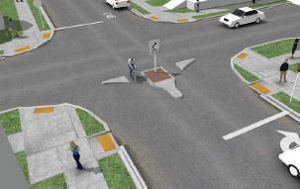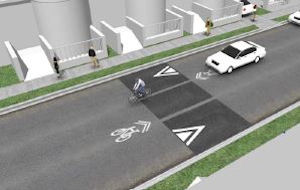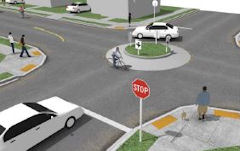by James A. Bacon
The City of Richmond doesn’t have many tangible results to show for its bicycle-friendly policies so far. Painting white bicycle symbols on a few streets to designate sharrows — lanes where cars should be on the look-out for bicycles — contributes only marginally to making streets safer for cyclists. But the city soon could create a street corridor that prioritizes bicycles over cars.
City Council voted last month to ask the Commonwealth Transportation Board to approve the Floyd Avenue Bike Boulevard project to improve bicycle and pedestrian mobility on Floyd Avenue in the city’s Fan and Museum districts.
As described in Richmond Connects, the city’s strategic multimodal transportation plan, a bicycle boulevard is a low volume, low-speed street that is “redesigned with features to further reduce the speed and volume of traffic and give priority to bicycles.”
The plan would convert Floyd to a bicycle boulevard for 27 blocks between Dooley Avenue and Laurel Street. The details remain to be seen. But traffic “diverters” could be installed at intersections to force local car traffic from Floyd onto other streets after a block or two. The diverters would be designed so that bicycles could ride through them. Another technique for slowing speeds might be to install speed lumps — like speed bumps but with cutouts for bicycles. Traffic islands at intersections are another option. Good signage and lane markings are critical.
“Residents and businesses would still retain access [to Floyd Avenue] but in some cases that access may be less direct than before the conversion,” states the transportation plan.
Floyd Avenue is well suited for such a project. The mainly residential street has a low volume of automobile traffic at present, and is little used by commuters driving into and out of Richmond’s central business district. The bicycle boulevard would terminate at Virginia Commonwealth University, where it would plug into the bicycle-friendly VCU campus. Moreover, it would run 27 blocks through the Fan and Museum districts, two of the most densely settled neighborhoods in Richmond, where cyclists can access a wide range of amenities.
The Richmond Metropolitan Planning Organization has recommended approval of $50,000 to pay for preliminary engineering. Assuming the scope and cost of the project stays on target, the MPO will recommend approval for the balance of the project cost, an additional $300,000. Eighty percent of the street makeover will be funded through the federal Transportation Alternative program; the city will pay the rest.
The Fan and Museum districts have a fair volume of bicycle traffic already, but streets are not designed to accommodate bicycles. Cyclists blowing through intersections are a frequent irritant to drivers. It is hoped that many cyclists will divert to the Floyd Bike Boulevard, where they will come into less conflict with cars.
Some residents of Floyd Avenue likely will complain that tilting the rules of the road in favor of bicycles and against cars will inconvenience them and diminish their property values. But the bother to motorists is marginal. And it is entirely possible that enhancing bicycle accessibility could bolster property values. This project will make an interesting experiment. I hope that city officials track property valuations over the next several years. Floyd Avenue could well prove to be the template for other bicycle boulevards.





